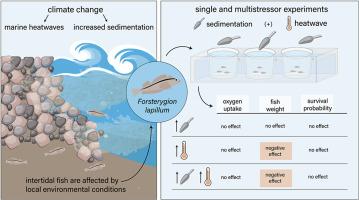Exposure of an intertidal fish to simulated heatwaves and suspended sediment – a multistressor approach
IF 2.9
2区 生物学
Q2 BIOLOGY
引用次数: 0
Abstract
Extreme climatic events, such as marine heatwaves (MHW) and increased suspended sediment concentration (SSC), are increasing in frequency and intensity, resulting in sudden changes to coastal environments, especially intertidal zones. Intertidal animals experience conditions that substantially fluctuate over temporal and spatial scales and therefore require the ability to physiologically tolerate these fluctuations. Since multiple stressors often co-occur and natural populations tend to respond to local environmental fluctuations, we aimed to investigate individual and combined effects of MHW and increased suspended sedimentation in Forsterygion lapillum from two neighbouring coastal areas with distinct water temperatures and wave current regimes by assessing fish oxygen consumption rate, mortality and weight loss. Results showed that in both F. lapillum populations, oxygen consumption rate and survival probability were unaffected by any treatment. However, fish from both populations lost weight during heatwave and multistressor treatments (i.e. heatwave and sedimentation), while fish from the sedimentation treatment alone did not lose weight. Although a direct effect on fish respiration was not found, our results indicate that F. lapillum performance is reduced when exposed to heatwaves individually and in combination with increased sediment suspension. Weight loss indicates that fish experiencing these stressors were unable to meet their metabolic demands.

潮间带鱼类暴露于模拟热浪和悬浮沉积物中——多压力源方法
极端气候事件,如海洋热浪(MHW)和悬浮沉积物浓度(SSC)的增加,频率和强度都在增加,导致沿海环境,特别是潮间带的突然变化。潮间带动物所经历的条件在时间和空间尺度上有很大的波动,因此需要有生理上容忍这些波动的能力。由于多种压力因素经常同时发生,自然种群倾向于对当地环境波动做出反应,我们的目标是通过评估鱼类的耗氧量、死亡率和体重减轻,研究来自两个邻近的水温和洋流不同的沿海地区的MHW和悬浮沉降增加的单独和综合影响。结果表明,两种群的耗氧量和存活率均不受任何处理的影响。然而,两个种群的鱼在热浪和多应激源处理(即热浪和沉积)期间体重减轻,而单独进行沉积处理的鱼体重没有减轻。虽然没有发现对鱼类呼吸的直接影响,但我们的研究结果表明,当单独暴露于热浪或与沉积物悬浮物增加相结合时,凤头藻的性能会降低。体重下降表明经历这些压力源的鱼无法满足它们的代谢需求。
本文章由计算机程序翻译,如有差异,请以英文原文为准。
求助全文
约1分钟内获得全文
求助全文
来源期刊

Journal of thermal biology
生物-动物学
CiteScore
5.30
自引率
7.40%
发文量
196
审稿时长
14.5 weeks
期刊介绍:
The Journal of Thermal Biology publishes articles that advance our knowledge on the ways and mechanisms through which temperature affects man and animals. This includes studies of their responses to these effects and on the ecological consequences. Directly relevant to this theme are:
• The mechanisms of thermal limitation, heat and cold injury, and the resistance of organisms to extremes of temperature
• The mechanisms involved in acclimation, acclimatization and evolutionary adaptation to temperature
• Mechanisms underlying the patterns of hibernation, torpor, dormancy, aestivation and diapause
• Effects of temperature on reproduction and development, growth, ageing and life-span
• Studies on modelling heat transfer between organisms and their environment
• The contributions of temperature to effects of climate change on animal species and man
• Studies of conservation biology and physiology related to temperature
• Behavioural and physiological regulation of body temperature including its pathophysiology and fever
• Medical applications of hypo- and hyperthermia
Article types:
• Original articles
• Review articles
 求助内容:
求助内容: 应助结果提醒方式:
应助结果提醒方式:


